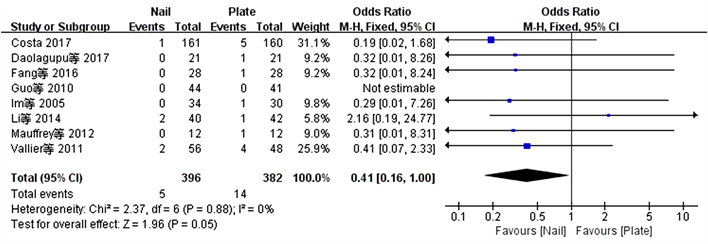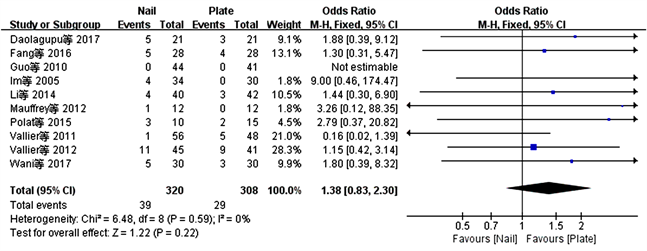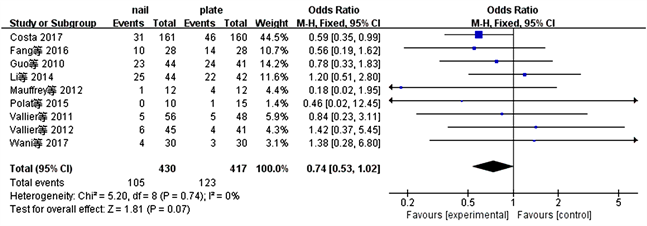摘要: 目的:系统评价髓内钉与钢板治疗胫骨远端骨折的疗效,为临床治疗提供循证证据。方法:检索Pubmed、Springer、Medline、The Cochrane Library、CNKI、万方数据库,中国期刊全文数据库,检索时间2005年1月至2022年1月。收集髓内钉与钢板治疗胫骨远端骨折疗效对比的相关随机对照研究,制定纳入及排除标准,并评估文献质量,采用RevMan5.3软件进行统计分析。结果:共纳入11篇RCT研究,共949例,其中钢板组468例,髓内钉组481例。合并结果显示:两组在手术时间、骨折愈合时间、骨折延期愈合率、骨折不愈合率、深部感染率、畸形愈合率、内固定物取出率方面差异无统计学意义(P > 0.05);而在术后浅表感染率方面钢板组高于髓内钉组(P < 0.05)。结论:髓内钉治疗胫骨远端骨折,在术后浅表感染率方面明显优于钢板组,而无证据显示其在手术时间、骨折愈合时间、骨折延期愈合率、骨折不愈合率、深部感染率、畸形愈合率、内固定物取出率方面优于钢板组。
Abstract:
Objective: To systematically evaluate the efficacy of intramedullary nail and plate in the treatment of distal tibia fracture, and to provide evidence-based evidence for clinical treatment. Methods: Pubmed, Springer, Medline, The Cochrane Library, CNKI, Wanfang Database and Chinese Journal Full-text Database were searched from January 2005 to January 2022. Randomized controlled studies on the efficacy comparison between intramedullary nail and plate in the treatment of distal tibial fractures were collected, inclusion and exclusion criteria were formulated, and literature quality was evaluated. Statistical analysis was performed using RevMan5.3 software. Results: A to-tal of 949 patients were included in 11 RCT studies, including 468 in the plate group and 481 in the intramedullary nail group. The combined results showed that there was no significant difference in operation time, fracture union time, delayed fracture union rate, fracture nonunion rate, deep in-fection rate, malunion rate and internal fixation removal rate between the two groups (P > 0.05). The superficial infection rate in the plate group was higher than that in the intramedullary nail group (P < 0.05). Conclusion: In the treatment of distal tibial fractures, intramedullary nailing is superior to the plate group in terms of postoperative superficial infection rate, but there is no evi-dence that it is superior to the plate group in terms of operation time, fracture union time, delayed fracture union rate, fracture nonunion rate, deep infection rate, malunion rate and internal fixation removal rate.
1. 引言
胫骨远端骨折的发生率为0.6%,约占所有胫骨骨折的10%~13% [1] 。车祸外伤是最常见的受伤原因,其次是跌倒、扭伤及其他低能量损伤。胫骨远端关节外骨折的治疗通常比胫骨干骨折更为复杂 [2] [3] 。胫骨远端(胫骨下1/3)骨折的最佳治疗方法仍然存在争议。由于胫骨远端软组织覆盖少,血液供应差及骨折接近踝关节,因此骨折处理较困难,并常出现皮肤坏死、感染、骨折畸形愈合及骨不连等并发症。目前钢板内固定和髓内钉内固定是最常见的手术方式。然而,目前还不清楚哪种方法能为患者提供更好的治疗效果。本研究对符合纳入及排除标准的RCT研究采用循证医学的方法进行Meta分析,比较髓内钉与钢板治疗胫骨远端骨折的疗效,以判断两种手术方式的优劣。
2. 资料与方法
2.1. 文献检索范围及策略
检索Pubmed、Springer、Medline、The Cochrane Library、CNKI、万方数据库,中国期刊全文数据库,维普数据库等数据库,检索时间2005年1月至2022年1月。收集髓内钉与钢板治疗胫骨远端骨折疗效对比的相关随机对照研究(randomized controlled trial, RCT)。中文检索词为:胫骨远端骨折、钢板、髓内钉。英文检索词为distal tibial fracture、fractures of tibia、Intramedullary nails、plate。根据制定的纳入及排除标准进行筛选。
2.2. 文献纳入与排除标准
纳入标准:① 文献类型:国内、外发表的髓内钉与钢板治疗胫骨远端骨折疗效对比的RCT研究,语言为英文。② 研究对象:明确诊断为胫骨远端骨折,不伴主要神经、血管损伤,不分种族、国家、性别。③ 文献中病例数 ≥ 10例,随访时间 ≥ 6月。文献排除标准:① 病理性骨折。② 非RCT研究,讲座、综述、评论等。
2.3. 数据提取
提取基本信息,包括研究作者、发表时间、研究类型、样本数量、性别比例、年龄、骨折类型及随访时间等。从文献中提取的连续性变量(手术时间、骨折愈合时间)和二分类变量(术后浅表感染率、术后深部感染率、骨折不愈合率、骨折畸形愈合率、骨折延期愈合率、内固定取出率)进行分析。骨折畸形愈合定义:在任何平面上角度大于5度或旋转畸形大于10度。骨折不愈合的定义:骨折后6个月内无愈合迹象。骨折延期愈合的定义:术后6~9个月没有达到临床愈合。
2.4. 文献质量评价
由2位独立的研究者阅读文献题目及摘要,挑选有可能符合的文献进行全文详细阅读,如确实符合标准,2位学者交叉检查。如两位作者之间有分歧由第三位作者解决或进行研究团队内讨论后决定。纳入的RCT研究采用Jadad量表 [4] 进行方法学质量评价,其中1~3分视为低质量,给予排除,4~7分视为高质量,则纳入研究中。所选文章的偏倚风险评估表,见图1。

Figure 1. Cochrane risk bias assessment table
图1. Cochrane风险偏倚评估表
2.5. 统计学处理
统计软件使用RevMan5.3软件进行数据分析。二分法变量采用比值比(odds ratio, OR)和95%可信区间(confidence interval, CI)表示,连续性变量采用均数差(mean difference, MD)或表均差均数(standard mean difference, SMD)及95%CI表示;I2判断异质性的大小,当I2 ≥ 50%,使用随机效应模式;若I2 ≤ 50%,使用固定效应模型。通过排除每个研究的结果分析敏感性,以确定结果稳定程度。P < 0.05被认为具有统计学意义。
3. 结果
3.1. 文献检索结果
经过文件检索,初步检出文献123篇,经过复筛阅读全文、质量评价后,最终纳入质量较高的RCTs11篇 [5] - [15] 。共949例,其中钢板组468个,髓内钉组481个,基本特征见表1。

Table 1. Basic information of the included literature
表1. 纳入文献的基本信息
注:RCT为随机对照研究。
3.2. Meta分析结
3.2.1. 手术时间
共有6篇研究 [5] [6] [7] [9] [10] 报道了手术时间,共纳入354例,其中髓内钉组177例,钢板组177例,森林图显示各研究间异质性较大(P = 0.15, I2 = 94%),采用随机效应模型分析。结果显示:两组间差异无统计学意义[MD = −9.58, 95% CI: 22.67~3.51, P = 0.15],见图2。

Figure 2. Forest plot of operation time comparison between the two groups
图2. 两组手术时间比较的森林图
3.2.2. 骨折愈合时间
共有7篇研究 [5] [6] [7] [9] [10] [13] [14] 报道了骨折愈合时间,共纳入414例,其中髓内钉组207例,钢板组207例,森林图显示各研究间异质性较大(P = 0.13, I2 = 59%),采用随机效应模型分析。结果显示:两组间差异无统计学意义[MD = −0.20, 95% CI: −0.45~−0.06, P = 0.13],见图3。

Figure 3. Forest plot of fracture healing time comparison between the two groups
图3. 两组骨折愈合时间比较的森林图
3.2.3. 术后浅表感染
共有10篇研究 [5] - [10] [12] [13] [14] [15] 报道了术后浅表感染发生事件数,共纳入863例,其中髓内钉组436例,钢板组427例,森林图显示各研究间异质性较小(P = 0.0004, I2 = 22%),采用固定效应模型分析。结果显示:两组比较差异有统计学意义[MD = 0.41, 95% CI (0.25, 0.67), P = 0.0004],髓内钉组术后浅表感染发生率低于钢板组,见图4。
3.2.4. 术后深部感染
共有8篇研究 [5] [7] [8] [9] [10] [12] [14] [15] 报道了术后深部感染发生事件数,共纳入778例,其中髓内钉组396例,钢板组382例,森林图显示各研究间异质性较小(P = 0.05, I2 = 0%),采用固定效应模型分析。结果显示:两组比较差异无统计学意义[MD = 0.41, 95% CI (0.16, 1.0), P = 0.05],见图5。

Figure 4. Forest map comparing superficial infection rates between two groups
图4. 两组浅表感染率比较的森林图

Figure 5. Forest map comparing deep infection rates between two groups
图5. 两组深部感染率比较的森林图
3.2.5. 骨折不愈合
共有7篇研究 [5] [7] [8] [9] [10] [12] [14] 报道了骨折不愈合发生事件数,共纳入557例,其中髓内钉组235例,钢板组222例,森林图显示各研究间异质性较小(P = 0.59, I2 = 0%),采用固定效应模型分析。结果显示:两组比较差异无统计学意义[MD = 1.29, 95% CI (0.52, 3.22), P = 0.59],见图6。

Figure 6. Forest plot of fracture nonunion rate comparison between two groups
图6. 两组骨折不愈合率比较的森林图
3.2.6. 骨折延期愈合
共3篇研究 [9] [10] [12] 报道了骨折延期愈合发生事件数,共纳入162例,其中髓内钉组80例,钢板组82例,森林图显示各研究间异质性较小(P = 0.96, I2 = 0%),采用固定效应模型分析。结果显示:两组比较差异无统计学意义[MD = 1.02, 95% CI (0.42, 2.51), P = 0.96],见图7。

Figure 7. Forest plot comparing delayed union rate of fracture between two groups
图7. 两组骨折延期愈合率比较的森林图
3.2.7. 骨折畸形愈合
共10篇研究 [5] - [14] 报道了骨折畸形愈合发生事件数,共纳入628例,其中髓内钉组320例,钢板组308例,森林图显示各研究间异质性较小(P = 0.22, I2 = 0%),采用固定效应模型分析。结果显示:两组比较差异无统计学意义[MD = 1.38, 95% CI (0.83, 2.30), P = 0.22],见图8。

Figure 8. Forest plot of malunion rate of fracture in two groups
图8. 两组骨折畸形愈合率的森林图

Figure 9. Forest plot comparing the removal rates of internal fixation between the two groups
图9. 两组内固定取出率比较的森林图
3.2.8. 内固定物取出率
共9篇研究 [6] - [13] [15] 报道了内固定取出事件数,共纳入847例,其中髓内钉组430例,钢板组417例,森林图显示各研究间异质性较小(P = 0.07, I2 = 0%),采用固定效应模型分析。结果显示:两组比较差异无统计学意义[MD = 0.74, 95% CI (0.53, 1.02), P = 0.07],见图9。
4. 讨论
胫骨远端骨折是骨科医生经常遇到的难题,手术治疗需要最大限度地减少软组织和骨膜的损伤,并且减少治疗引起的并发症。目前钢板固定及髓内钉固定二者中哪种固定方式更为优异尚存在争议。虽然钢板固定对骨折进行解剖复位及坚强固定,但是软组织并发症相对较多,其中最常见的是伤口裂开和感染 [16] 。髓内钉固定具有微创、避免广泛软组织剥离,出血少、保持血管供应完整等优点,但是稳定性欠佳,有骨折蔓延到踝关节的风险,并骨折断端复位不良,容易出现骨折畸形愈合 [17] [18] 。本Meta分析的目的是通过RCT研究,比较钢板固定和髓内钉固定的临床疗效,并分析一系列结果指标,确定胫骨远端骨折的最佳手术策略。本研究中对纳入的11篇RCT研究中的6个二分类变量(浅表感染、深部感染、骨折不愈合、骨折畸形愈合、骨折延期愈合、内固定取出率)和2个连续性变量(手术时间、骨折愈合时间)进行合并分析。结果显示髓内钉组比钢板组在浅表感染发生率[MD = 0.41, 95% CI (0.25, 0.67), P = 0.0004]上存在优势。而在手术时间、骨折愈合时间、深部感染、骨折不愈合、骨折畸形愈合、骨折延期愈合发生率方面差异无统计学意义。胫骨远端骨折手术治疗后感染率约0%~50% [10] [19] [20] [21] 。钢板组感染率明显高于髓内钉组 [8] [22] [23] 。有关综述报道 [24] ,对于轻度软组织损伤的胫骨远端关节外骨折,建议行钢板固定,尤其是经皮微创钢板固定。但对于有严重软组织损伤的骨折,应优先考虑髓内定。Im等 [5] 对64例胫骨远端关节外骨折的患者随机进行髓内钉固定与钢板固定,随访2年后发现,两组患者的骨折愈合时间及踝关节骨折功能评分方面无显著差异,而在伤口并发症的数量上有明显差异:髓内钉组有1例,钢板组有7例,得出结论是,髓内钉是首选治疗方法。在一项Meta分析中,Zelle等 [25] 纳入了1125例胫骨远端关节外骨折的患者,他们认为髓内钉固定与钢板固定的患者中,骨不连、骨折畸形愈合和感染率方面没有显著差异。Yang等 [26] 认为与钢板组相比,髓内钉组骨折愈合时间较短,但术后外翻畸形平均增加3.7˚。Janssen等 [16] 研究表明,在胫骨远端骨折中,髓内钉很难控制骨折断端对位。据文献报道 [12] [27] [28] [29] [30] ,在评估骨折愈合时间和最终愈合率方面,钢板和髓内钉治疗结果相近。Vallier [31] 等对111例髓内钉与钢板治疗的患者进行随访,随访4年后发现,髓内钉组延迟愈合、畸形愈合和二次手术更为常见。
总之,胫骨远端关节外骨折的患者,钢板固定的术后浅表感染发生率明显高于髓内钉固定,两种治疗方法在手术时间、骨折愈合时间、深部感染、延迟愈合、骨不连及畸形愈合的发生率上无显著差异。对于严重软组织损伤的胫骨远端关节外骨折,建议采用髓内钉固定,对于轻度软组织损伤的患者,采用钢板固定。
本Meta分析存在以下不足之处:① 本研究只纳入了11篇RCT研究,样本量小,研究结果可能存在一定的偏倚。② 本研究中大多数文章的随访时间都在2年内,缺乏对长期临床疗效的观察。③ 我们只关注主要并发症,没有比较其他结果,如术中出血量、患者满意度、前膝疼痛和术中透视时间、踝关节功能评分等,因为这些指标不总是被报道或测量方法不同,可能影响分析结果,缺乏规范统一的评价体系。④ 本研究纳入了11篇RCT研究,其中5篇文章对比髓内钉与传统钢板固定,6篇对比髓内钉与经皮微创钢板,因此内固定的种类不同,可能影响最终结果。在今后的研究中,我们拟进行大样本、多中心、RCT研究以更新结论,并为临床工作给予相对更可靠的参考数据。
作者贡献
海拉提·巴合提、石守印进行文章的构思与设计;海拉提·巴合提、孙俊刚进行研究的实施与可行性分析;海拉提、肖伟进行数据收集、整理;海拉提·巴合提进行统计学处理,结果的分析与解释,撰写论文,对文章整体负责,监督管理;海拉提·巴合提、石守印、肖伟进行论文的修订;石守印、孙俊刚负责文章的质量控制及审校。
利益冲突
本文无利益冲突。
NOTES
*通讯作者。